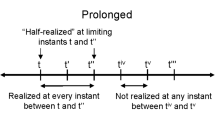Abstract
Experience suggests that any form of time is an advancing sequence of states of affairs, which is ordered but not necessarily measured. The observed temporality of the universe is attributed to the divine life. Time in God is taken to be unmeasured. The model postulates a program running in God’s time and represented by a black box, which produces a temporal universe chosen from the tree of actualizable worlds. Physical time is then a totally ordered independent variable for physical processes, with its measures derived from these processes. As usual, physical theories are regarded as more particular models of the resulting temporal universe. The theistic model is applied to relativity, quantum mechanics, philosophy, and theology. To avoid speculation, God’s time is further described by intervals of unknown internal structure. With God’s time in the background, there is a conceptual integration of God and the universe.
Access this chapter
Tax calculation will be finalised at checkout
Purchases are for personal use only
Similar content being viewed by others
References
Danto, Arthur and Sidney Morgenbesser. 1967. Philosophy of science. Cleveland: World Publishing Company, Meridian Books, 7th printing, 322.
Donne, John. 1624. Meditation XIV, http://www.online-literature.com/donne/406 (accessed July 29, 2009).
Feynman, R.P. 1961. Quantum electrodynamics. New York: W. A. Benjamin, 68.
Feynman, R.P. 1949. The theory of positrons. Physical Review 76(6): 749–759.
Fraser, J.T., F.C. Haber, and G.H. Müller, eds. 1972. The study of time. Proceedings of the first conference of the International Society for the Study of Time, Oberwolfach (Black Forest) – West Germany. Berlin: Springer, 320.
McGrath, A.E. 2002. A scientific theology, vol. 2. Edinburgh: T & T Clark, 268–279.
Newton, Isaac. 1934. Scholium to the definitions in Philosophiae Naturalis Principia Mathematica, Bk. 1 (1689); trans. Andrew Motte (1729), rev. Florian Cajori. Berkeley: University of California Press.
Pennings, T.J. 1993. Infinity and the absolute: insights into our world, our faith, and ourselves. Christian Scholars Review 23(2): 159–180.
Prior, A.N. 1958. The syntax of time distinctions. Franciscan Studies 18: 105–120.
Prior, A.N. 1967. Past, present and future. Oxford: Clarendon Press, 203–205.
Reichenbach, H. 1956. The direction of time. Berkeley: University of California, 268.
Rucker, Rudy. 1995. Infinity and the mind. Boston: Birkäuser, 1982; repr. Princeton: Princeton UP.
Russell, R.J. 1997. The God who infinitely transcends infinity. In How large is God? ed. John Marks Templeton, 137–165. Philadelphia: Templeton Foundation Press.
Somayaji, D.A. 1971. A critical study of the ancient Hindu astronomy in the light and language of the modern. Dharwar: Karnatak University, 73.
Steinhart, Eric C. 2009. A mathematical model of divine infinity. Theology and Science 7(3): 261–274.
Stone, A.P. 1997. A program model of becoming. Physics Essays 10(1): 150–163.
Stone, A.P. 2009. “Time,” http://homepage.ntlworld.com/stone-catend/time.htm (accessed 22 September 2009).
Whitrow, G.J. 1980. The natural philosophy of time, 2nd ed. Oxford: Clarendon Press, 332–335.
Wildman, Wesley J. 2004. The divine action project, 1988–2003. Theology and Science 2(1): 31–75.
Zinkernagel, Henrik. 2008. Did time have a beginning? International Studies in the Philosophy of Science 22(3): 237–258.
Author information
Authors and Affiliations
Corresponding author
Editor information
Editors and Affiliations
Rights and permissions
Copyright information
© 2011 Springer Science+Business Media B.V.
About this chapter
Cite this chapter
Stone, A.P. (2011). A Theistic Model of Physical Temporality. In: Tymieniecka, AT., Grandpierre, A. (eds) Astronomy and Civilization in the New Enlightenment. Analecta Husserliana, vol 107. Springer, Dordrecht. https://doi.org/10.1007/978-90-481-9748-4_30
Download citation
DOI: https://doi.org/10.1007/978-90-481-9748-4_30
Published:
Publisher Name: Springer, Dordrecht
Print ISBN: 978-90-481-9747-7
Online ISBN: 978-90-481-9748-4
eBook Packages: Humanities, Social Sciences and LawPhilosophy and Religion (R0)



